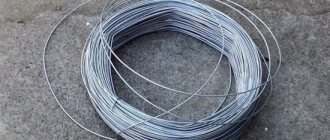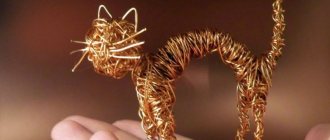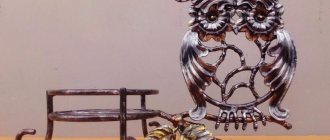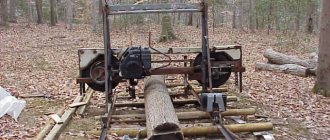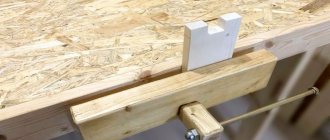Tools and materials
Viking knit or “Viking Knot” is one of the oldest techniques for creating chains. It owes its poetic name to archaeological research in the Scandinavian countries, during which similar jewelry was found.
This weaving does not require soldering at all, which makes the task much easier. In addition, the gimp can be constantly lengthened, creating a product of the desired size.
To create the Viking Knot chain you will need the following:
- A coil of thin copper wire;
- Scissors;
- Pencil;
- Ruler.
Patination and polishing of copper.
I love making antique copper jewelry. I like the color of aged copper. For patination, you can use ammonia, which is sold in pharmacies in Russia. Pour ammonia into a glass jar with an iron lid. We make a hole in the lid with an awl and hang the product ABOVE on a wire!!! ammonia solution. Observe the change in color of copper. At the right time, we take out the product, wash and polish it.
For patination (blackening) you can use special solutions. which can be purchased in online stores. Read the instructions. I bought the blackening solution at the Crafts Fair. I completely dipped the jewelry into the solution, then polished it.
We polish the polishing surface with a machine using special felt attachments. We use polishing pastes. I use GOI paste.
To prevent the copper wire from darkening over time and staining the skin, the copper can be coated with a special varnish. I completely immerse the product in Tsapon varnish. I dry it for about an hour and put it in varnish again. I dry it for a day. Zapon varnish can be purchased at hardware stores.
The decoration is ready! We wear, give or sell! Find out how to sell handmade products on the Internet on my website for making money.
POPULAR MASTER CLASSES: DIY wire jewelry. Wire wrap technique. Wire pendant. DIY wire wrap jewelry.
Save the Pin below as a bookmark to your Pinterest board!
Did you like the master class!? Don't be lazy - share with your friends on social media. networks. It won’t be difficult for you, but it will be a pleasure for me!
Master class: How to make a wire chain with your own hands.
Making a chain in the Viking style is not difficult, you just need to follow these steps step by step: First, you need to prepare the base on which the first loops of the future decoration will be placed.
This is done like this:
- cut a piece of copper wire about 40 cm in size and wrap it around the ruler 6–7 times.
- Carefully remove the resulting winding and, to secure it, twist it with the free end of the thread.
- After this, you need to move apart, literally open the “flower” of the attached loops. We do this as carefully as possible so as not to bend the wire and spoil the appearance of the product.
- After this, the resulting “flower” needs to go around the edge of the pencil.
- Next, we take another piece of material (about 80 cm) and begin the main process - weaving.
- First of all, we make a loop around one of the so-called “petals”. It is important to remember to leave a small piece of free material.
- For the next loop, we retreat to the right to the adjacent “petal”. To complete this row, you need to knit 4 wire loops and return to the first.
- Then we move on to a new level. To do this, we make another loop, catching on the first from the previous row.
Important! You need to act slowly and carefully so as not to accidentally damage the gimp. Otherwise you'll have to start over.
- In this way we continue to weave a new row. We do this until the free segment is shortened to 12–15 cm.
- To continue knitting, you need to lengthen the gimp. To do this, we take a new piece of material (70–80 cm), which we place under the vertical row. While weaving, you should carefully grab the new wire along with the loop from the previous row for a strong fixation.
- Then, using the new segment, you need to make another loop. At this stage it is important to act as accurately as possible. We bring out the new piece to the left of it, pointing upward, and with the old working wire we cling to the right, leading down.
- We weave the old wire together with the loop of the previous row several times to ensure thorough fixation, then cut off all excess.
- Next, we continue weaving according to the above scheme to the required size - for a bracelet, necklace or something else. When determining the length, it is worth considering that the finished chain is usually stretched twice.
- To complete the work, remove the finished product from the pencil. Carefully take the ends, stretch the resulting weave without sudden movements and look at the result.
Execution technique
To make a wire bracelet with your own hands, you must first decide on the weaving technique, because the result will depend on it. After which you need to draw up a step-by-step action plan, select the decor, and then start weaving.
Let's take a closer look at the different methods and features of their implementation.
- Weaving. A braid is made from several pieces of wire, which will eventually need to be flattened to create a more stylish effect, as well as for better fixation.
- To make a braid, you need to take several thick wire elements and thin wire. Depending on your preferences, you can wrap thin wire around thick parts, connecting them together and forming an original pattern.
- Bending and forging are ideal for creating openwork elements. Thick wire is bent to form the desired pattern, then flattened with a hammer, thereby fixing the bends and intersections of the parts.
- Decoration - thanks to this technique, beads, seed beads and other decoration elements can be woven into wire patterns.
- Often, bracelets are made from individual links connected to each other.
To better understand the technology for making wire bracelets, let's look at step-by-step examples using simple options.
Minimalistic bracelet without clasp
To make this product, you need to measure a piece of wire according to the volume of your wrist, as well as pieces to create a decorative element.
The main decor consists of spiral-shaped details at the ends of the bracelet, which are made using bending and forging, and metal beads are attached to the product using braiding technology.
Bracelet with original clasp
To make this product, you will need a piece of thick wire corresponding to the circumference of your wrist, a thinner wire with a reserve, pliers and a hammer.
The surface of the bracelet itself is made using the braiding technique, and both ends are bent into loops that will serve to attach the clasp. The end of a piece of thinner wire must be threaded into one of the resulting loops, after which the piece is twisted into a spiral at one end and into a hook at the other. We fix everything with a hammer. The resulting hook and free loop form a clasp.
Useful tips for making a wire chain
There is another way to make a Viking Knot. It consists of using the most ordinary crochet hook and soft thin wire.
Important! The thickness of the gimp must necessarily correspond to the thickness of the instrument. Otherwise, the process will become significantly more complicated, and you won’t get a beautiful, even weave!
Crocheting a chain is quite easy and does not require special skills. This is done like this: when the first loop is ready, you need to carefully hook the next one and pull it through the previous one. It just sounds complicated, but in fact, a person can figure out the technology even without such experience. Next, carefully pull out the threaded loop to the required length. The process of pulling out the loops is repeated until the decoration reaches the desired size. That's all!
- If desired, the decoration can be made not from copper wire, but from brass, silver or steel.
- But don't choose one that's too thick.
- And in order for the metal used to become soft and pliable, it must be annealed. This can be done over an ordinary gas burner.
- The main thing to remember is safety precautions!
Features of work
- Craftsmanship is required to make almost all products. There is no need to immediately take on complex work, but start with simple crafts.
- It is advisable to use metals that are not subject to oxidation. The finished item can be varnished.
- The wire will become softer if you heat it over a fire.
- It is necessary to make a sketch of the future product on paper before starting work.
- It is important to follow safety precautions while working.
Making gold chains with your own hands
Gold chains are wonderful jewelry that is suitable not only for women, but also for men.
Learning how to make a gold chain with your own hands is a great idea for a jewelry maker. A gold chain is a luxurious piece of jewelry that attracts the attention of people around you, and for a jeweler, chains provide a wide scope for the embodiment of fantasies and creativity. It often happens that the chain breaks easily, although it does not look so fragile. It is impossible to even imagine that this chain can support the weight of a weight. Why does this happen? In this article we will try to understand and answer this question. To begin with, let’s take a general look at all the stages of making gold chains.
The jeweler takes a small bar of pure gold, which was obtained after refining. Separates the required amount and mixes it with the ligature. This is done to ensure that the gold chain is strong and durable. To obtain the necessary alloy for making a chain, you need to take 5.85 grams of pure gold, 2.92 grams of copper and 1.22 grams of silver.
We fuse all these metals in a crucible, sprinkle with borax, and be sure to stir. The melting point is about 950 degrees. After hardening, the hot piece of metal is cooled in water and boiled in bleach. As a result, we get 10 grams of 585 gold alloy, which indicates the percentage of gold in the product.
The higher the purity, the higher the pure gold content, but the much softer the alloy. Impurities of other metals not only impart hardness and strength to gold, but also change its color. By replacing the ratio of metals that make up the ligature, the required color for the future decoration is selected.
To make a chain, we pour gold into a mold and get a gold rod about 5 mm thick. In order to make a chain from it, you now need to burn it and stretch it to the state of a wire of the required diameter, which depends on the mass of the future product.
To do this, you need to pass our rod first through rollers, from a larger stream to a smaller one, and then through dies. When rolling on rollers, it is very important not to confuse the size of the strand, since if you put a gold rod into a strand of a smaller size, cracks will appear, and as a result, when pulled through dies, the wire will break and the future product will be of poor quality. When working with dies, it is necessary to lubricate the wire with the wax of a regular candle.
After completing the stage of making gold wire, the process of weaving the chain itself begins. First of all, the resulting gold wire is twisted into a spiral of the required diameter, then from the spiral, using special scissors, we cut links for the future chain. We weave the resulting links into a chain of the required length and solder them using solder. Next comes the process of polishing and installing the lock.
Soldering thin circuits
What about thin chains?
After all, small links cannot be soldered manually. What to do in this case? Typically, thin chains are produced on special machines, in large jewelry factories and factories. To solder the links, the chains are coated with a special powder, which is a mixture of solder and flux. This powder envelops the junction of each link, then the chains enter the muffle furnace, where the temperature ranges from 500-600 degrees. At this temperature, the gold itself simply glows while the solder melts, joining the joints. The chain is now strong and ready for further processing.
Wire bending machines
Mechanical machines for the mass production of parts and finished products from metal wire are widely used in industrial production. Depending on the technology used to shape the finished product, there are:
- A wire bending machine that produces parts directly from a coil. It is the most productive and economical option for mass production of wire products.
This happens due to the fact that the coil of wire is installed in a special device - an unwinder, from which the metal thread enters the correct block. There it is exposed to a roller or plane mechanism, as a result of which the output takes the form of an even and straight rod. After this, the wire enters the bending unit of the machine, where, with the help of mechanical devices, it is given the required shape of the finished product. At the end of the process, the finished part is cut with mechanical scissors. Typically, such a wire bending machine can produce one type of finished product, which is determined by pre-installed mechanical devices and limited by the ability to manipulate the feed mechanism. Therefore, the shapes of products produced on such machines are not very complex in configuration, since the number of bending operations is limited to five. - A wire bending machine for bending wire from a metal rod is a more technologically advanced method, which has a number of advantages compared to working from a coil. This is especially necessary when the finished product requires additional processing. This can be threading or stamping, which can only be done until the finished product is shaped. The disadvantages of such a machine are its need for an additional complex mechanism for feeding workpieces and relatively low overall productivity.
- The wire bending machine for bending wire using the rolling method is mainly used for the production of various round-shaped parts and various types of round springs. For example, such a machine for bending wire by rolling works due to the fact that the wire is fed through guide rollers onto a shaft of a given radius, where, due to its rotational movement, it bends around the finger a given number of times. In this case, the wire is twisted along a given radius, which has a bending finger and rolling rollers. Due to the position of the rolling rollers relative to the central shaft, the bending angle or spring pitch can be set and adjusted. A wire bending machine by rolling, like other similar mechanical devices, is capable of producing only one type of product per operation. To change the range of products, both the replacement of bending devices and commissioning work are required.
- Wire bending machine for bending metal wire using the pushing method.
For certain wire parts, during their manufacture, it is necessary to give them complex shapes of certain geometric shapes, such as variable radii, irregular arcs, spiral appearance, and the like. It is not very effective to do this by running in, and sometimes it is even technologically impossible. Hence, the only possible way is to use the wire pushing method. The principle of operation is the forward movement of metal wire through a three-roll roll forming unit or a special spring-coiling device, in which the shape of the finished product is given due to the position of the rolling rollers. As a result, you can obtain any given curvature or a smooth change in the size of the radius. The main difference between rolling and other bending methods is that the equipment is more complex, requiring special knowledge during setup and maintenance. - Straightening machines are used as an additional device in technological lines for the production of various metal wire mesh for straightening the wire and giving it a certain shape. Two technologies are used here: straightening using the rotation method using a frame and straightening using a two-plane straightening block. The two-plane block does not straighten very perfectly, but it does not twist the wire. But the rotating straightening frame has a more complex design, but many machine tool manufacturers still prefer it to the classic straightening block design.
Diamond shape
The armored type of weaving has polished links located in the same plane. Interlocking loops have a rhombic shape and can be connected with one, two or even three links at a time. There are various combinations of armor weave. For example, small links are woven into large ones or sequentially alternate with each other. The first species is called "Nonna", the second - "Figaro". Another weaving method, which can have a square, oval or round cross-section, is called “Snake” or “Cobra”. Indeed, the cord in appearance resembles a snake’s shell and is slightly curved. Rope chain weaving also belongs to the armored type. When connecting the links, the chain rotates slightly in a certain direction, resembling a rope in appearance.
sea anchor
With the anchor method, the connected links interlock with each other at an angle of 90 0. The loops of a classic chain are oval shaped. This is the simplest weaving method that you can use to make a chain with your own hands. If there is a crossbar between the links, then the weaving is called “Sea Anchor”. There is a coupling of not only narrow, but also wide rings - rollo or chopard. Venetian weaving differs from classical weaving by links that can take the shape of a square or rectangle. One block can contain several elements.
Making a bracelet
A simple weaving that does not involve soldering each individual link and involves working with a large piece of wire can be called Viking Knit. In this technique, each subsequent link in the chain must be artificially increased until the entire chain is closed. It’s not difficult to make a beautiful wire bracelet with your own hands. To do this you will need to acquire:
- Thin copper wire.
- Scissors.
- Metal ruler.
- With a simple pencil.
Weaving a double diamond chain
This type of clutch has flat loops shaped like a diamond or an elongated square. Weaving is considered quite durable and popular. The links can be connected one by one, or in groups of two or three pieces together. Women's chains, as a rule, have a flat shape. Men, in turn, prefer massive products with double or triple weave.
The prepared links are stretched, bent and compressed to achieve the required shape. Then weave a chain by inserting the next loop into the previous one. There is a hitch option in which the third link is threaded into the first and passed through the second, then the fourth is threaded into the second and pulled through the third, and so on. After soldering the loops, the finished chain is flattened using rollers. At the end of the work, the hand-woven chain must be polished.
Methods for bending metal wire
There are several main ways to give metal wire the required shape of the finished product, so we can highlight:
- manual method of bending wire using special tools and simple devices. It is used for wire with a diameter of up to 3 mm in the manufacture of simple products in utility production or households. As a rule, it does not require virtually any financial investment or special knowledge;
- manual method of making jewelry from wire up to 2 mm in diameter. Requires special tools and devices, as well as certain knowledge and skills for working with precious metals;
- bending wire from a coil, which is based on a special device called an unwinder;
- bending wire from a metal rod;
- bending using wire rolling method;
- bending metal wire using the pushing method.
Sources:
- https://art-fashn.ru/prochee/pletenie-iz-provoloki-dlya-nachinayushhih-master-klass-i-shemy-pleteniya.html
- https://vplate.ru/podelki-iz-provoloki/vse-o-pletenii/
- https://vsesamodelki.ru/podelki-iz-provoloki/
- https://hockey-samara.ru/rukodelie/braslet-iz-mednoj-provoloki-svoimi-rukami.html
- https://vplate.ru/podelki-iz-provoloki/kak-sdelat-kreativnyj-braslet/
- https://babudacha.ru/2016/10/10/kak-plesti-iz-provoloki-sxemy-i-idei-podelok/
- https://WikiMetall.ru/metalloobrabotka/gibka-provoloki.html
Bismarck chain weaving technology
The main tools for making jewelry are various crossbars, vices, pliers, files and additional materials. At home, knitting needles or any other needles, for example from an umbrella or a bicycle wheel, can be used as crossbars to weave a chain around the neck. A wire is wound around it, forming a spiral. One end needs to be bent in two places, forming a handle, and a cut must be made on the other to secure the wire.
Next, the spiral must be cut into links so that each loop contains two turns. Then the second is screwed into one element using pliers until a characteristic click is heard. In this way, the product is extended to the required length. When weaving a chain, two turns of each link must be compressed to secure it.
To solder the loops you need solder. It is an alloy of various metals in the form of thin plates or wire. Before soldering, you need to take a small piece of solder and melt it with a burner flame. Then move the ball with a soldering iron to the joint of the link, which also needs to be heated, and let it spread. Repeat the procedure with the remaining loops. In the final step, the chain is aligned by pulling it through the rollers.
Copper wire butterfly
With the help of small tongs you can learn how to make curls from wire, on the basis of which you can easily make unusual products. For example, a miniature butterfly with cute wings.
The following will be useful for work:
- copper wire
- large oval bead
- forceps
- glue
Step-by-step instruction:
- From the blank you need to form the silhouette of a butterfly. Using pliers, starting from one edge, carefully twist the wire into a curl.
- Then the wing is formed. First the larger upper part of the wing, then the lower one.
- The wire must be bent and the formation of the second wing must be started in the reverse order.
- Then a second curl is created.
- The last step is gluing an oval-shaped bead to the center of the craft, imitating the body of a butterfly.
Weaving chains with your own hands
A product woven using the Viking Knit method is made of soft wire and does not require soldering. When weaving a chain around the neck, the material used is increased.
Before work, you need to prepare a pencil that will serve as a support, thin copper wire, scissors and a ruler. Weaving begins with preparing the base for the chain. Cut about 40 cm of copper thread and wrap it around the ruler, making 6 turns. Remove the resulting loops from the tool and secure them by wrapping them with the short end of the wire. Move the petals in different directions and place them on the blunt side of the pencil, bending them along the support. Start weaving with a new piece of copper thread 80 cm long. Make a loop by threading the wire through one of the warp petals. Then, turning the pencil, insert the upper end of the thread inside the next petal, bringing it out on the left side. In this way, tie loops around the entire base.
The new row begins with the girth of the loop of the previous circle. Then weaving continues in the same way until the working wire runs out. Twist the tip of the new piece of thread with the previous remainder and continue weaving to the required length. Subsequently, this tip will be hidden in the work. Please note that at the end of the work the chain must be stretched. Its length will almost double.
Using the methods discussed above, both men's and women's chains can be woven. By learning to make jewelry, you will gain good experience with metal and learn basic jewelry making skills.
History of wire use
People began using it as a material for creativity and creating necessary household items 3000 BC. Archaeologists have been able to establish that in Sumer (around 2600 BC.
) wire was used to make women's hair ornaments, which were gold and silver ribbons.
Over time, it began to be used to make chain mail, candlesticks, horse brushes and other things.
But where did the craftsmen get the wire suitable for such products? Initially, it was created in a rather labor-intensive way: sheets of metal were cut into thin strips, then twisted together and rolled between two flat sheets.
The second way to obtain it was also to wind thin metal strips onto a round core. Today, it is produced by drawing it through special conical molds, which is why the method of its production is called drawing.
Most often, wire weaving involves the use of copper wire, which has a beautiful appearance and color. In addition, wire made of brass, steel, silver and aluminum is used in needlework. In addition to everything on sale, you can find wire with an additional coating (an alloy of other metals), which allows you to change its color.
Also, an important characteristic of any wire is its diameter. Handmade products use wire with a diameter of 0.2 to 2.0 mm.
Even though today there are a large number of special devices and devices, working with wire can hardly be called simple. After all, in order to create the simplest jewelry, the master needs to have on hand:
- Pliers
- Side cutters
- Round nose pliers
- Anvil
- Device for winding springs
- Hammer
- and Jig-Wig (a plate with rows of holes and special nozzles of various diameters)
Each of the above tools must be used correctly. And this, of course, takes time. Therefore, you should not expect that everything will work out the first time.
However, the presence of such difficulties does not mean that wire is an unpopular material among needlewomen.
On the contrary, it enjoys special attention among handmade craftsmen, because it makes it possible to create complex, exclusive jewelry, the likes of which cannot be found.
Well, now let’s get down to the fun part and tell you what you can create from wire. First of all, these are, of course, earrings, bracelets, rings and all kinds of necklaces and pendants. The variety of weaving techniques, as well as their combination with bright stones and other decorative elements, allows you to create a large number of different women's jewelry.
They all differ in design style, so they can be selected for a wide variety of occasions.
For example, this is what earrings might look like:
Most of them have a complex curled shape. Some are made in the form of small studs, while others, on the contrary, are made in the form of large and massive earrings. Here are some examples:
As already mentioned, chains and pendants are often made from wire. Chains can have completely different shapes and diameters, which completely depends on the chosen weaving technique. In addition, needlewomen often like to complement them with unusually shaped pendants, which together look cute and quite original.
As for pendants, they can either consist entirely of wire or be a cabochon braided with it. The choice of one or another method of creating a pendant or pendant depends entirely on the imagination of the master and the materials at his disposal.
If desired, you can also make complete sets of jewelry from wire. Below is a video tutorial on how this is done in practice. During it, you can see what it takes for a master to create even a seemingly very basic decoration with his own hands:
Wire rings:
However, you should not assume that the wire is no longer good for anything. In the handmade world, everything is possible. That’s why in many homes you can see wicker trees, coasters, candlesticks, bottle holders, decorative figurines and many other wire products.
- Alternatively, it could be these cute butterflies and dragonflies:
- All of them fit perfectly into a modern interior, and can also be selected to decorate a house decorated in any other style.
